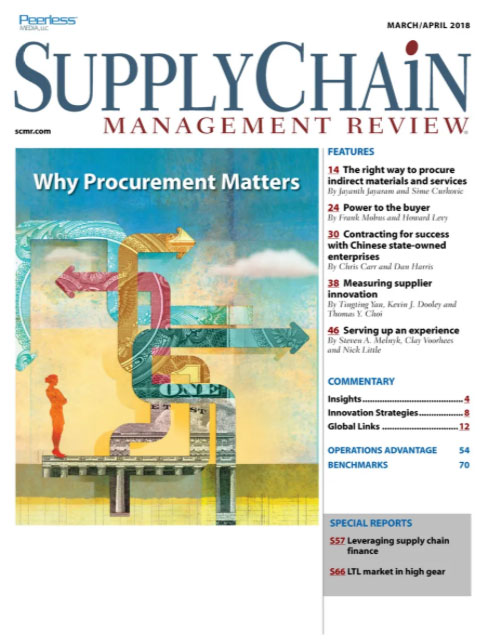Sorry, but your login has failed. Please recheck your login information and resubmit. If your subscription has expired, renew here.
March-April 2018
"Inflation creeps into U.S. Supply Chain.” So said the headline on a Wall Street Journal article I read this morning before writing this column. The Journal went on to write that U.S. companies are grappling with rising material and ingredient costs on top of pressure from higher wages—a potential double whammy— and noted that companies like Whirlpool and Ford have already issued warnings to the market. Browse this issue archive.Need Help? Contact customer service 847-559-7581 More options
Although India is the world’s 7th largest economy and one of the fastest growing economies on the planet, it lags many developing countries— notably China—on indicators of innovation such as R&D spend and the economic contribution of high-tech manufacturing. World Bank data from 2011, the most recent year, indicates that India’s expenditure on R&D as a percentage of GDP is only 0.82% compared to China’s, which is currently 2.0% and rising. India lags on other indicators such as the number of researchers in R&D and the volume of high-tech exports. While India’s vast educational infrastructure produces huge numbers of engineers and other technically qualified graduates every year, thousands of engineering graduates move to developed economies every year to further their studies.
Countries benefit on several fronts from a strong high-tech manufacturing base. Such a base reduces the nation’s reliance on expensive imports, generates exports and jobs, and supports a healthier trade balance. Technologically advanced companies help countries to compete more effectively in high-value markets. Yet, the increase in competition and economic activity in India over the last 25 years has not translated into a commensurate jump in innovation activities.
A new study of India’s ability to support the growth of high-tech manufacturing startups (HTMs) concludes that many of the underlying reasons for the country’s relatively poor performance lie in the supply chain. Conducted by MISI, a member of the MIT Global SCALE Network, in collaboration with the Indian Institute of Management, the study aimed to answer two fundamental questions:
- What are the factors that affect the performance and competitiveness of high-tech manufacturing startups in India?
- How does the country improve and develop the performance of this sector by fostering growth through the design of supportive ecosystems?

This complete article is available to subscribers only.
Log in now for full access or start your PLUS+ subscription for instant access.
SC
MR
Sorry, but your login has failed. Please recheck your login information and resubmit. If your subscription has expired, renew here.
March-April 2018
"Inflation creeps into U.S. Supply Chain.” So said the headline on a Wall Street Journal article I read this morning before writing this column. The Journal went on to write that U.S. companies are grappling… Browse this issue archive. Access your online digital edition. Download a PDF file of the March-April 2018 issue.Although India is the world's 7th largest economy and one of the fastest growing economies on the planet, it lags many developing countries— notably China—on indicators of innovation such as R&D spend and the economic contribution of high-tech manufacturing. World Bank data from 2011, the most recent year, indicates that India's expenditure on R&D as a percentage of GDP is only 0.82% compared to China's, which is currently 2.0% and rising. India lags on other indicators such as the number of researchers in R&D and the volume of high-tech exports. While India's vast educational infrastructure produces huge numbers of engineers and other technically qualified graduates every year, thousands of engineering graduates move to developed economies every year to further their studies.
Countries benefit on several fronts from a strong high-tech manufacturing base. Such a base reduces the nation's reliance on expensive imports, generates exports and jobs, and supports a healthier trade balance. Technologically advanced companies help countries to compete more effectively in high-value markets. Yet, the increase in competition and economic activity in India over the last 25 years has not translated into a commensurate jump in innovation activities.
A new study of India's ability to support the growth of high-tech manufacturing startups (HTMs) concludes that many of the underlying reasons for the country's relatively poor performance lie in the supply chain. Conducted by MISI, a member of the MIT Global SCALE Network, in collaboration with the Indian Institute of Management, the study aimed to answer two fundamental questions:
- What are the factors that affect the performance and competitiveness of high-tech manufacturing startups in India?
- How does the country improve and develop the performance of this sector by fostering growth through the design of supportive ecosystems?
 SUBSCRIBERS: Click here to download PDF of the full article.
SUBSCRIBERS: Click here to download PDF of the full article.
SC
MR


Latest Supply Chain News
Latest Podcast

 Explore
Explore
Topics
Software & Technology News
- Nine questions are the key to AI success in building resilient supply chains
- Looking back at NextGen 2024
- AI is moving omnichannel closer to the customer
- How technological innovation is paving the way for a carbon-free future in logistics and supply chains
- Körber Supply Chain Software’s Craig Moore says MercuryGate acquisition is about the customer
- Robotic use grows by 10%
- More Software & Technology
Latest Software & Technology Resources

Subscribe

Supply Chain Management Review delivers the best industry content.

Editors’ Picks





